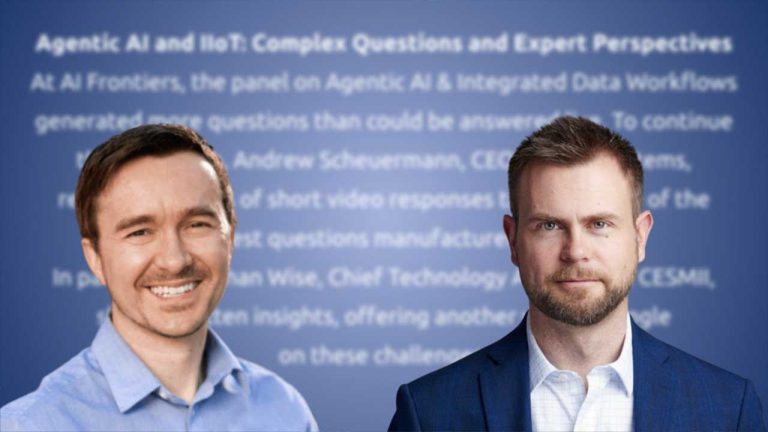Breaking Free from POC Purgatory: Transitioning AI Projects to Production
Transitioning a promising AI Proof-of-Concept (POC) into a fully operational production environment is a critical, and often challenging, step in realizing the value of AI investments. The panelists of the “AI-Driven Process Optimization: Achieving Faster Turnarounds and Higher Margins” session that took place at IIoT World Sustainability and Artificial Intelligence Day, although primarily focused on the benefits and challenges of AI in manufacturing, offer valuable insights into overcoming the barriers that can trap projects in perpetual POC mode.
- Define Clear Business Goals and Success Criteria:
- Don’t Do AI for AI’s Sake: The panelists emphasized the importance of starting with a well-defined business problem rather than simply adopting AI as a technological novelty. This means:
- Identifying Pain Points: What are the most significant inefficiencies, bottlenecks, or quality issues that AI could potentially address?
- Quantifying Value: What are the specific, measurable improvements (e.g., increased throughput, reduced downtime, improved quality) that the AI solution is expected to deliver?
- Setting Realistic Expectations: Avoid overpromising or setting unrealistic targets that the AI solution may not be able to achieve, especially in the early stages.
- Establish Clear Success Metrics and KPIs: Define how the performance of the AI solution will be measured and tracked, ensuring alignment between technical goals and business outcomes. This could include metrics like:
- Accuracy, precision, recall, or F1-score for tasks like defect detection or predictive maintenance
- Reduction in cycle time, downtime, or scrap rate for process optimization applications
- Improvement in customer satisfaction or other relevant business metrics.
- Align Stakeholders on Objectives: Secure buy-in from key stakeholders across technical teams, management, and business units to ensure a shared understanding of goals and expectations. This will be essential for securing the resources and support needed for a successful transition to production.
- Address Data Challenges Proactively:
- Ensure Access to the Right Data:
- Data Relevance and Representation: As highlighted in the discussion, the data used to train and evaluate AI models must accurately reflect the real-world complexities of the manufacturing process. This means having access to data that captures:
- Variations in Operating Conditions: Different machine generations, product variants, material types, and environmental factors can all impact process behavior.
- Rare Events and Anomalies: Understanding and predicting these events is crucial for many AI applications, but they are often underrepresented in typical datasets.
- Data Quality and Labeling: High-quality data is the foundation of successful AI. Invest in:
- Data Cleaning and Preprocessing: Address missing values, inconsistencies, and errors in the data.
- Accurate and Consistent Labeling: This is particularly crucial for supervised learning tasks, where the quality of labels directly impacts model performance.
- Data Governance and Security: Establish clear policies and procedures for:
- Data Access and Sharing: Address concerns about intellectual property, data privacy, and the potential misuse of sensitive information.
- Data Security and Compliance: Ensure that data is handled in accordance with relevant regulations and industry best practices.
- Data Relevance and Representation: As highlighted in the discussion, the data used to train and evaluate AI models must accurately reflect the real-world complexities of the manufacturing process. This means having access to data that captures:
- Design for Data Scalability and Accessibility:
- Data Integration and Management: Modern manufacturing environments generate vast amounts of data from disparate sources. Invest in robust data infrastructure and tools that can:
- Integrate data from different systems (e.g., MES, SCADA, ERP)
- Manage data volume, velocity, and variety
- Provide secure and efficient access to data for AI applications.
- Data Pipelines for Continuous Learning: Build automated data pipelines that can ingest, process, and feed data into AI models on a continuous basis. This allows the models to adapt to changing conditions and improve their performance over time.
- Data Integration and Management: Modern manufacturing environments generate vast amounts of data from disparate sources. Invest in robust data infrastructure and tools that can:
- Design for Scalability, Generalizability, and Maintainability:
- Avoid the “POC Trap” of Over-Specialization:
- Design for Adaptability: Build AI solutions with future needs in mind. Consider how the models will accommodate:
- New Product Lines
- Process Changes
- Factory Expansions
- Potential Integration with Other Systems
- Leverage Transfer Learning: Techniques like transfer learning can help create models that can be more easily adapted to new scenarios, reducing the need to build entirely new models from scratch.
- Design for Adaptability: Build AI solutions with future needs in mind. Consider how the models will accommodate:
- Prioritize Model Maintainability and Governance:
- Model Monitoring and Drift Detection: Implement mechanisms to continuously monitor model performance in production and detect any degradation or “drift” over time. This allows for timely retraining or adjustments to ensure continued accuracy and reliability.
- Model Versioning and Management: Establish clear processes for versioning, documenting, and managing AI models throughout their lifecycle. This ensures that models are traceable and auditable and that the organization can easily revert to previous versions if needed.
- Foster a Culture of Collaboration, Learning, and Continuous Improvement:
- Break Down Silos: Encourage open communication and collaboration between data scientists, engineers, domain experts, and business stakeholders throughout the AI lifecycle.
- Invest in Training and Reskilling: Equip teams with the skills and knowledge needed to develop, deploy, and manage AI solutions effectively. This includes both technical skills and an understanding of AI principles, limitations, and ethical considerations.
- Embrace Experimentation and Learning: Create a culture that encourages experimentation and views failures as opportunities for learning and improvement. This will help accelerate the organization’s ability to identify what works and rapidly iterate on AI solutions.
Successfully transitioning AI projects from POC to production requires a shift from a purely technical focus to a more holistic approach that considers business goals, data management, model scalability, and organizational factors. By addressing these key areas, companies can increase their chances of transforming promising AI concepts into tangible business value.
This summary was created by NotebookML and ChatGPT based on the video transcript of the “AI-Driven Process Optimization: Achieving Faster Turnarounds and Higher Margins” session that took place at IIoT World Sustainability and Artificial Intelligence Day. It was edited by the IIoT World team.
Related articles:



